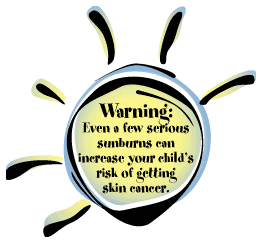 |
|
|
| National Center for Chronic Disease Prevention and Health Promotion | ||||
|
|
 |
 |
|
|
| Cancer Home | About Us | Events | En Espaρol | Site Map | Contact Us | ||||
|
|
|||||||||||||||||||||
|
||||||||||||||||||||||
|
You may also download a PDF version (147K) for Adobe Acrobat Reader.
|
 |
1. Hide and Seek. UV rays are strongest and most harmful during midday, so it's best to plan indoor activities then. If this is not possible, seek shade under a tree, an umbrella or a pop-up tent. Use these options to prevent sunburn, not to seek relief once it's happened. |
 |
2. Cover em Up. Clothing that covers your child's skin helps protect against UV rays. Although a long-sleeved shirt and long pants with a tight weave are best, they aren't always practical. A T-shirt, long shorts or a beach cover-up are good choices, too but it's wise to double up on protection by applying sunscreen or keeping your child in the shade when possible. |
 |
3. Get a Hat. Hats that shade the face, scalp, ears, and neck are easy to use and give great protection. Baseball caps are popular among kids but they don't protect their ears and neck. If your child chooses a cap, be sure to protect exposed areas with sunscreen. |
| 4. Shades Are Cool. And they protect your child's eyes from UV rays, which can lead to cataracts later in life. Look for sunglasses that wrap around and block as close to 100% of both UVA and UVB rays as possible. | |
 |
5. Rub on Sunscreen. Use sunscreen with at least SPF 15 and UVA/UVB protection every time your child goes outside. |
|
Sunscreen Scoop Sunscreen comes in a variety of forms lotions, sprays, wipes, or gels. Be sure to choose one made especially for kids with:
For most effective protection, apply sunscreen generously 30 minutes before going outdoors. And, don't forget to protect ears, noses, lips, and the tops of feet which often go unprotected. Take sunscreen with you to reapply during the day, especially after your child swims or exercises. This applies to "waterproof" and "water resistant" products as well. Keep in mind, sunscreen is not meant to allow your kids to spend more time in the sun than they would otherwise. Sunscreen reduces damage from UV radiation, it doesn't eliminate it. The American Academy of Pediatrics now advises that sunscreen use on babies less than 6 months old is not harmful on small areas of a baby's skin, such as the face and back of the hands. But your baby's best defense against sunburn is avoiding the sun or staying in the shade. |
||
Protect the Skin They're In

Too Much Sun Hurts
Did you know that just a few serious sunburns can increase your
child's risk of skin cancer later in life? Kids don't have to be at the
pool, beach, or on vacation to get too much sun. Their skin needs
protection from the sun's harmful ultraviolet (UV) rays whenever they're
outdoors.
Turning pink? Unprotected skin can be damaged by the sun's UV rays in as little as 15 minutes. Yet it can take up to 12 hours for skin to show the full effect of sun exposure. So, if your child's skin looks "a little pink" today, it may be burned tomorrow morning. To prevent further burning, get your child out of the sun.
Tan? There's no other way to say it tanned skin is damaged skin. Any change in the color of your child's skin after time outside whether sunburn or suntan indicates damage from UV rays.
Cool and cloudy? Children still need protection. UV rays, not the temperature, do the damage. Clouds do not block UV rays, they filter them and sometimes only slightly.
Oops! Kids often get sunburned when they are outdoors unprotected for longer than expected. Remember to plan ahead, and keep sun protection handy in your car, bag or child's backpack.
Parents, help your children play it safe in the sun and protect your own skin as well. You're an important role model.
When you play it safe, you're playing it smart.
For more information about protecting your family from skin cancer, contact:
You may also download a PDF
version (147K) for Adobe
Acrobat Reader.
|
*Links to non-Federal organizations found at this site are provided solely as a service to our users. These links do not constitute an endorsement of these organizations or their programs by CDC or the Federal Government, and none should be inferred. The CDC is not responsible for the content of the individual organization Web pages found at these links. Privacy Policy | Accessibility Cancer Home | About DCPC | Events | Site Map | Contact Us CDC Home | Search | Health Topics A-Z Page last reviewed: Monday, April 05, 2004 United States Department of Health and
Human Services |